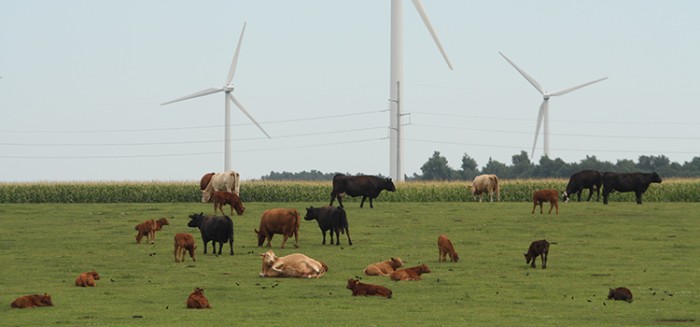Last year, the state generated more than 30% of its electricity from wind power, the second highest in the country. But with the construction of the CapX2020 transmission portfolio, which will provide access to new markets, and some recent improvements to the state’s tax climate, South Dakota is a state ripe for significant new wind development opportunities.
Indeed, there is a major build-out of wind being planned in the Mount Rushmore State. Even though South Dakota gets nearly a third of its electricity from wind power, with just 977 MW installed, the state lags well behind neighboring states such as North Dakota, Minnesota and Iowa in installed capacity.
But that may soon change, however. According to the American Wind Energy Association’s Second Quarter Market Report, South Dakota currently has 90 MW under construction and an additional 600 MW in advanced development.
And wind companies are interested in doing much more business in the state. South Dakota spans two different regional transmission organizations, the Midcontinent Independent System Operator and the Southwest Power Pool, and planners for those two entities are currently studying thousands of megawatts of new utility-scale wind energy projects for potential development. The development of these projects will bring significant economic development to the state, adding to the $2.1 billion in capital investment the state has already received.
As utilities in the Midwest seek to add additional clean energy resources on their system, particularly as the federal production tax credit winds down, South Dakota is one of the states poised to take advantage of this new market demand. South Dakota already receives millions in local tax revenue from existing wind development, and the farmers and ranchers who lease their land to wind projects are benefiting from significant lease payments that provide a drought-resistant source of income. South Dakota companies, such as Marmen Energy in Brandon, which manufactures wind towers, or MFG Wind in Aberdeen, which manufactures and services wind turbine components, are directly benefiting from the development of wind energy in South Dakota.
But the real opportunity lies on the horizon in South Dakota. Several large wind projects have recently been announced in the state, including the 600 MW Crowned Ridge project. This wind farm is part of Xcel Energy’s plans to add over 1.5 GW of low-cost wind energy to its system over the next several years. Not only will this project – and others like it – provide cost-effective electricity for residents of South Dakota and beyond, but these projects will also drive billions of dollars of private investment in the state, providing millions in new tax revenue to communities and landowners, as well as creating hundreds of new jobs.
This level of development is not without challenges, however. Several anti-wind organizations have formed in South Dakota in recent years, each one with a seemingly increasing level of sophistication. In a state where wind energy facilities are permitted at the local county level, these groups have targeted several counties and pushed for restrictive setbacks. Although these organizations say they support renewable energy, they argue that burdensome setbacks are needed to protect property values, the public health and the viewshed of rural residents. And, in Lincoln County, in the southeast corner of the state, they recently succeeded in enacting and upholding a half-mile setback, effectively banning future wind development in the county.
And while these challenges are not unique to South Dakota, the number of megawatts on the line and the fact the state spent nearly a decade working to address transmission constraints and fixing an uncompetitive tax climate to get to this point makes this a fascinating state to monitor. Several other counties in the state are actively weighing modifications to their zoning ordinances in response to proposed wind farm development. In many cases, the justification for these changes is based on misinformation and anxiety stemming from the activism of these dedicated anti-wind organizations. At least two South Dakota newspapers recently editorialized that county officials are wise to promote more restrictive setbacks, basing their opinions on outdated or ill-informed information.
Over the years, numerous political voices – from governors to the Congressional delegation to state lawmakers – have led the charge in building out the infrastructure in South Dakota that is needed to accommodate the anticipated growth in wind power. Sen. John Thune, R-S.D., may have said it best when he spoke at the September 2015 groundbreaking ceremony of the Big Stone South – Brookings 345 kV transmission line, part of the CapX2020 portfolio, when he likened the importance of the project for local wind development to the railroad tracks and trains that are needed to move corn out of the state. Republican governor Dennis Daugaard has made clear his position on this industry, saying in June 2016, "I will continue to promote the expansion of renewable energy, including South Dakota's excellent wind resource, within our state, given its many economic and environmental advantages." Now that key projects like Big Stone South – Brookings are nearing final completion, it is crucial that these political leaders continue their advocacy and remain engaged to see these wind projects cross the finish line, the culmination of their years of hard work in supporting South Dakota’s energy economy.
“I will continue to promote the expansion of renewable energy, including South Dakota’s excellent wind resource, within our state, given its many economic and environmental advantages.
Governor Dennis Daugaard (R)
The ability of each individual wind company to overcome the opposition of a vocal minority will determine the future of wind energy in South Dakota. Companies must continue to educate the public about the benefits that this investment will provide – while also working hard to address legitimate issues when they arise. Finding local community leaders who understand these benefits, leveraging the existing fact-based literature that counteracts the opposition’s talking points, and developing strong relationships with decision-makers and the community at large will all be critical to building the support needed to move forward with a wind project.
It’s not enough, however, to find and deploy wind supporters only when trouble arises. Developers would be wise to proactively recruit, engage and cultivate their supporters long after the first battle is fought. Continuing to keep in touch through open houses, newsletters, social media and other means will prove very helpful when the tables turn again and there is a need for those supporters to show up at the Capitol or local hearings and talk about the benefits the project has provided.
If companies are successful in building this level of support, it will mean substantial new economic opportunities for people across the state of South Dakota, and it could propel the state into the leadership circle with neighboring states in the nation’s wind belt.

